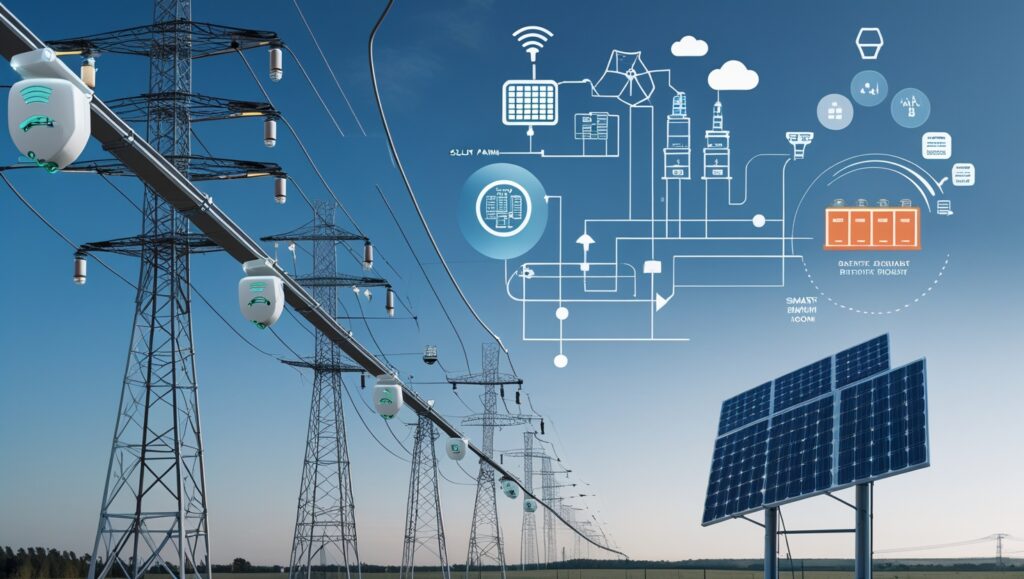Powering Progress: Why Smart Grid Investments Are Cambodia’s Next Green Energy Frontier

Cambodia is rapidly emerging as a compelling narrative of green energy ambition in Southeast Asia. With impressive strides in deploying renewable power, particularly large-scale solar farms, the kingdom is firmly committed to a sustainable and resilient energy future. However, as more intermittent green energy sources come online, a critical question arises: How can Cambodia ensure this clean power reliably reaches every home and business, supporting sustained economic growth? The answer lies in modernizing the nation’s electricity grid through smart grid investments. This vital upgrade is not merely a technical necessity; it represents a monumental opportunity for international investors to actively shape Cambodia’s green revolution, fostering energy stability and unlocking unprecedented growth.
- The Current Landscape: Unpacking Cambodia’s Grid Challenges
- Government’s Vision: Powering a Smarter, More Resilient Cambodia
- The Smart Grid Solution: Investment Avenues for Global Partners
- Why Cambodia is Ripe for Smart Grid Investment Now
- Conclusion: Powering Cambodia’s Green Future, Together
- Frequently Asked Questions (FAQs) about Smart Grid Investments in Cambodia
The Current Landscape: Unpacking Cambodia’s Grid Challenges
While Cambodia has achieved remarkable progress in expanding electricity access across the country, its existing grid infrastructure faces significant challenges that underscore the urgency for modernization. Much of the current transmission and distribution network is aging, leading to inefficiencies and notably high energy losses. Data often indicates transmission and distribution losses that can sometimes exceed regional averages, directly impacting the cost and reliability of power delivered to end-users.
Integrating large volumes of intermittent renewable energy sources, such as solar power, presents a complex challenge for a conventional grid. Traditional grids are designed for centralized, predictable power flow, making them susceptible to voltage fluctuations, frequency deviations, and overall instability when faced with the variable nature of solar generation. While new generation capacity is rapidly expanding, the pace of grid development and upgrades sometimes lags behind, creating potential bottlenecks that hinder the full utilization of Cambodia’s growing renewable energy portfolio. Furthermore, the widespread adoption of advanced monitoring, forecasting, and automated control systems—critical components of a modern grid—is still in its early stages. This limitation affects real-time visibility and the agility needed to manage a dynamic energy mix.
Government’s Vision: Powering a Smarter, More Resilient Cambodia
The Royal Government of Cambodia is acutely aware of these infrastructure challenges and has squarely placed grid modernization at the heart of its long-term energy strategy. Within the nation’s comprehensive Power Development Plan (PDP), transforming the national grid into a more robust, resilient, and “smart” system is a clearly articulated strategic priority. This forward-thinking vision emphasizes not only physical infrastructure upgrades but also the integration of cutting-edge digital technologies to enhance efficiency, stability, and reliability.
The government’s commitment extends to creating a conducive policy and regulatory environment that actively encourages private sector participation. Initiatives are underway to streamline processes, provide clear guidelines, and offer incentives that make Cambodia smart grid investment highly attractive. By proactively engaging with international development partners and private companies, the government is signaling its unwavering dedication to building a sophisticated energy backbone that can support sustainable economic growth and secure Cambodia’s energy future.

The Smart Grid Solution: Investment Avenues for Global Partners
The very challenges currently facing Cambodia’s grid infrastructure translate directly into significant investment opportunities for global technology providers and energy infrastructure developers. These are not merely needs but growth areas poised for substantial returns:
- High-Voltage Transmission & Distribution (T&D) Upgrades:
- Opportunity: Investing in the construction of new, high-efficiency transmission lines and modern substations. This also includes upgrading existing infrastructure to reduce technical losses and expand network reach to unserved or underserved areas.
- Benefits for Investors: Tapping into a clear and urgent demand for foundational infrastructure, with long-term revenue potential tied to energy distribution and capacity growth. This is a critical component for ensuring the stability of a reliable power supply.
- Advanced Metering Infrastructure (AMI) / Smart Meters:
- Opportunity: Deployment of smart meters across residential, commercial, and industrial sectors. These devices enable real-time data collection, remote monitoring, and automated billing.
- Benefits for Investors: Opportunities in hardware supply, software development, data analytics, and maintenance services. Smart meters reduce non-technical losses, improve billing accuracy, and empower consumers with better energy management, which enhances operational efficiency for power utilities.
- Grid Automation & Control Systems (e.g., SCADA & ADMS):
- Opportunity: Implementation of advanced Supervisory Control and Data Acquisition (SCADA) systems and Advanced Distribution Management Systems (ADMS). These technologies enable remote monitoring, fault detection, and automated grid self-healing capabilities.
- Benefits for Investors: Solutions providers can offer comprehensive system integration, software platforms, and specialized engineering services. Such systems significantly improve grid stability, reduce outage durations, and allow for more efficient renewable energy grid integration in ASEAN.
- Battery Energy Storage Systems (BESS):
- Opportunity: Investment in utility-scale battery storage solutions. These systems can store excess renewable energy when generation is high and release it when demand peaks or renewable output drops, providing critical grid stability.
- Benefits for Investors: High growth potential as the cost of battery technology decreases. BESS projects offer revenue streams from grid services (frequency regulation, voltage support) and energy arbitrage, firming up intermittent renewable output for reliable supply.
- Cybersecurity for Energy Infrastructure:
- Opportunity: Providing specialized cybersecurity solutions tailored for operational technology (OT) networks within the energy sector, protecting smart grid components from cyber threats.
- Benefits for Investors: A growing, niche market with high demand as grid digitalization increases. Essential for ensuring the resilience and security of critical national infrastructure.

Why Cambodia is Ripe for Smart Grid Investment Now
Beyond the specific technological needs, several overarching factors make Cambodia an exceptionally attractive destination for smart grid investment opportunities.
- Strong Economic Growth: Cambodia continues to demonstrate robust economic expansion, driving a consistently increasing demand for reliable and affordable electricity. This growing market fundamentally guarantees a need for sophisticated energy infrastructure.
- Supportive Regulatory Environment: The Cambodian government’s clear and consistent commitment to attracting foreign direct investment (FDI) in critical infrastructure, coupled with ongoing efforts to streamline policies and provide incentives, creates a stable and predictable environment for investors.
- Abundant Renewable Resources: With significant untapped potential in solar, mini-hydro, and biomass, Cambodia is poised for a massive clean energy build-out. This very potential necessitates smart grid solutions for efficient integration and management.
- Strategic Geographic Advantage: Cambodia’s position within ASEAN facilitates regional energy connectivity and grid harmonization efforts, potentially opening doors for cross-border projects and broader market access.
- ESG Investment Alignment: Investing in Cambodia’s smart grid directly aligns with global Environmental, Social, and Governance (ESG) mandates. Investors can contribute significantly to Cambodia’s sustainable development goals, carbon reduction targets, and enhanced energy equity.

Conclusion: Powering Cambodia’s Green Future, Together
Cambodia’s journey towards a greener, more resilient energy future is critically linked to the modernization of its electricity grid. While the nation faces tangible infrastructure challenges, these are precisely what define the Cambodia smart grid investment opportunity. The government’s clear vision, proactive policies, and the immense potential for renewable energy convergence create a fertile ground for global technology providers and investors.
By investing in Cambodia’s smart grid, international partners are not merely making a financial commitment; they are becoming integral architects of a sustainable legacy. This is an invitation to secure significant returns, contribute to Cambodia’s energy independence, and help power a nation towards unparalleled prosperity and environmental stewardship. The time to invest in Cambodia’s smart grid revolution is now.
Frequently Asked Questions (FAQs) about Smart Grid Investments in Cambodia
- Q: Why is smart grid technology particularly important for Cambodia’s energy sector right now?
- A: Smart grid technology is crucial for Cambodia to efficiently integrate its rapidly growing renewable energy capacity (especially solar, which is intermittent) into the national grid. It enhances stability, reduces losses, and ensures a reliable power supply to meet increasing demand from a growing economy.
- Q: What specific types of smart grid technologies are most needed in Cambodia?
- A: Key needs include Advanced Metering Infrastructure (AMI) or smart meters, robust grid automation and control systems (like SCADA), battery energy storage systems (BESS) for grid balancing, and solutions for cybersecurity of energy infrastructure.
- Q: How is the Cambodian government supporting foreign investment in grid modernization?
- A: The Royal Government of Cambodia has prioritized grid modernization within its Power Development Plan (PDP) and offers a supportive regulatory environment, streamlined investment procedures, and welcomes public-private partnerships to attract international capital and expertise.
- Q: What are the key benefits for international investors in Cambodia’s smart grid sector?
- A: Investors can tap into a rapidly growing market driven by strong energy demand, benefit from a stable and supportive policy framework, contribute to Cambodia’s sustainable development goals (ESG alignment), and secure long-term returns from essential infrastructure development.
- Q: Are there opportunities beyond just technology provision, such as for training or maintenance?
- A: Absolutely. Investment opportunities extend to training and capacity building for local workforces, long-term maintenance and operation contracts for smart grid systems, and technology transfer initiatives that build local expertise.
- Q: Where can foreign investors find more detailed information on smart grid project tenders or opportunities in Cambodia?
- A: Information on specific tenders or investment opportunities can typically be found through official channels like Electricité du Cambodge (EDC), the Ministry of Mines and Energy (MME), and the Council for the Development of Cambodia (CDC) websites, as well as via international development banks like the ADB or World Bank.



